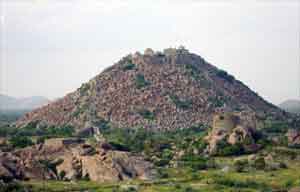
Gingee Fort - 1983
In 1983, when I was posted as the District Collector of South Arcot District, I was informed about a unique fort situated in the northwestern corner of the district in the centre of Gingee Taluk. Apart from being a unique architectural feat it is one of the few forts in the State. Tamil Nadu is famous for its temple architecture, whereas Rajasthan is well known for its forts and palaces. In this context, the existence of Gingee fort in itself is a landmark architectural event in Tamil Nadu. The town of Gingee is surrounded by several hills made of barren volcanic rocks. Each of these hills has a very jagged summit and a central stratified rock, topped with huge rounded boulders. Even though the land is dry and barren the landscape of Gingee is unique and marvellous. The hills around are devoid of vegetation except for a thick growth of thorny shrubs and the fortifications of Gingee stand on three such hills.
The three hills form the angular points of a rough equilateral triangle. A huge rampart, about 60 ft. in thickness and a ditch about 80 ft. in breadthencloses the entire space, going all around it. The walls are built of strong blocks of granite. This massive enclosed track forms the lower fort. It is three miles in perimeter and has two main entrances piercing it, namely, the Arcot or Vellore gate and the Pondicherry gate. The fort of Gingee has existed for several hundred years; several ruling dynasties are connected with the history of the fort, including Vijaynagar Maharajas, Shivaji Maharaj, Nawabs of Arcot, Tipu Sultan, the French and British. However, the legend of the fort is most popularly connected with the story of Raja De Singh, perhaps the only Rajput ruler to rule Tamil Nadu. The ballads about his courage and valour, his devotion to duty and his loyalty to his friends, are sung even today in the villages around Gingee. Equally famous is his horse that has been buried in Gingee close to his master. The character of Raja De Singh is reminiscent of the stories of Maharana Pratap of Chittoor and his horse Chetak.
I also discovered a community of Gingee Muslims who are quite unique. They are the descendents of the early Mughal army commanders. Their ancestors originally came to India along with the first Mughal emperor Babar. They continued to serve Humayun, Akbar, Jahangir, and Shahjehan but fell out with Aurangzeb. The story of their estrangement with Aurangzeb is as follows. Very early in their rule, in India, the Mughal emperors realised the importance of maintaining peace and friendship with the Rajput kings and making strategic alliances with them. As a result over a period of time the Mughal kings started marrying the Rajput women. Humayun married a Rajput princess. Akbar's wife and Jahangir's mother, Jodhabai, was the sister of a famed Rajput Commander Man Singh. This was emulated by not only the future kings, but also by their courtiers and army commanders.
The community of Urdu speaking Muslims that settled in Gingee belonged to this category of military personnel. They had been the products of mixed marriages. They were Muslims, per say, but due to their maternal influences were observing many Hindu customs and celebrating Indian festivals like holi, diwali and so on. All went well till the reign of Shahjehan. However, from the time Aurangazeb came to power the whole scenario changed. The liberal and secular minded Mughal commanders were issued a warning, with immediate effect, or were to face the consequences. The leaders of the community did not tolerate the change and in the pitch of darkness they escaped from somewhere around Meerut in UP where they were then stationed.
According to legend, it is the original image of Ranganatha from the famous Srirangam temple, which was taken away, from Srirangam and hidden in Gingee, for the sake of safety, during the plundering of Srirangam at the hands of the Mohammedan invader Malik Kafur. Lord Ranganatha is said to have been the tutelary Lord of Gingee and the personal deity (isht devata) of Raja Desingh. There is an underground tunnel that connects the Rajagiri fortress with the temple and is supposed to have been used by Raja Desingh and his queen to visit the temple unobserved. The existence of the tunnel itself is an indicator of the authenticity of the image. The fact that the idol was hidden among the rocks in a discarded Jain rock cut cave and was being worshipped unobserved by the public is enough proof of the idol being a very ancient and important one.
They offered their services to Maharaja Shivaji, the archenemy of Aurangzeb. Maharaja Shivaji was only too happy to enroll them in his army and utilise their services against Aurangzeb. It appears that Shivaji's empire at one point expanded up to Gingee. The legendary Raja De Singh, a Rajput King, could have been his vassal. It appears that when the Muslim Chieftains of Deccan owing alliance to Aurangzeb attacked Gingee, Shivaji sent a contingent of Muslim commanders loyal to him to help Raja De Singh. After they won the battle they were offered jobs in Gingee to stay on and protect the fort. Since then they have settled there and some of them have moved to the city of Madras and are important members of the community. One Mr. Choudury possesses the family tree showing all their ancestors and tracing their migration from North to South.
C K Gariyali IAS
Source : Chennaionline.com